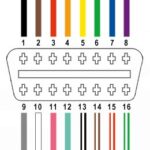Understanding your car’s On-Board Diagnostics (OBD) system is crucial for diagnosing and fixing issues. Whether your vehicle uses the older OBD1 or the more modern OBD2 system dictates the type of diagnostic tools you’ll need. Both systems monitor your engine and emissions, alerting you to problems through the check engine light and stored diagnostic trouble codes. However, they differ significantly in their interface and capabilities. Knowing how to identify whether your car is OBD1 or OBD2 is the first step towards effective car maintenance.
So, how do you determine if your car is OBD1 or OBD2? Here are several straightforward methods to help you identify your vehicle’s OBD system.
Checking Your Car’s Manufacturing Year
One of the easiest ways to get a strong indication of your car’s OBD type is by checking its manufacturing year. The OBD2 standard became mandatory in the United States for all cars manufactured for sale starting in 1996.
- Cars manufactured in 1995 or earlier are likely to be OBD1. Before the standardization of OBD2, manufacturers used various proprietary OBD1 systems.
- Cars manufactured in 1996 or later are almost certainly OBD2. This is due to the legal requirement for OBD2 compliance from 1996 onwards.
While the manufacturing year is a strong indicator, there’s a slight overlap. Some manufacturers started implementing OBD2 systems as early as 1994 and 1995 as they transitioned to the new standard. Therefore, while year is a good starting point, it’s not the only definitive method.
Inspecting the Diagnostic Connector
A more definitive way to tell if your car is OBD1 or OBD2 is by physically inspecting the diagnostic connector itself. The OBD connector is the port where diagnostic scanners are plugged in to read vehicle data.
-
OBD2 Connector: The OBD2 standard mandated a universal 16-pin Diagnostic Link Connector (DLC). This connector is trapezoidal in shape and features two rows of eight pins each. If you locate a 16-pin connector under your dashboard, your car is almost certainly OBD2.
-
OBD1 Connectors: OBD1 systems were not standardized, meaning each manufacturer could use different connectors. OBD1 connectors can vary in shape and pin count, and are often found in different locations than OBD2 ports. They are generally not 16-pin and can be round, rectangular, or even have multiple pins in a line.
Where to Find the Connector: The OBD port is typically located inside the passenger compartment of your vehicle. Common locations include:
- Under the dashboard on the driver’s side, often near the steering column.
- Below the dashboard near the center console.
- Sometimes, it may be hidden behind an access panel or ashtray.
- Less commonly, it could be in the glove box area or near the gear shift.
You should be able to locate the connector without any tools. Look for a port that resembles the descriptions above.
Checking for an Emissions Certification Label
Another method to identify your car’s OBD type is by looking for an emissions certification label under the hood. This label is usually found in the engine compartment, often on the underside of the hood or on the radiator support.
-
OBD2 Compliance Indication: The emissions sticker on OBD2 compliant vehicles will often explicitly state “OBD-II Certified” or “OBD2 Compliant”. It may also mention meeting EPA emissions standards, which for post-1996 vehicles, implies OBD2.
-
OBD1 Era Labels: Older vehicles with OBD1 systems will not have this specific OBD-II certification mentioned on their emissions labels. The label will generally focus on basic emissions compliance without referencing OBD standards directly.
While not all labels will explicitly say “OBD1” or “OBD2”, the presence of “OBD-II Certified” is a strong indicator.
Consulting Your Owner’s Manual
Your vehicle’s owner’s manual can also provide information about the OBD system. Check the section in your manual that discusses vehicle diagnostics, engine control systems, or emissions.
-
OBD2 Information: Manuals for OBD2 vehicles will often mention OBD-II, OBD2, or On-Board Diagnostics II. They may also describe the location of the 16-pin DLC and its function.
-
OBD1 Information (or lack thereof): Manuals for older OBD1 vehicles may have less detail about the diagnostic system, or refer to it in more general terms without specifically mentioning OBD1.
Understanding OBD2 Scanners and OBD1 Compatibility
A common question is whether OBD2 scanners can read OBD1 systems. The short answer is generally no, not directly.
-
Incompatible Interfaces: OBD1 and OBD2 systems use different communication protocols and, crucially, different connector interfaces. An OBD2 scanner is designed to plug directly into the 16-pin OBD2 DLC. It cannot physically connect to most OBD1 connectors without an adapter.
-
Adapters and Limitations: While adapter cables exist to connect an OBD2 scanner to some OBD1 connectors, these are not a guaranteed solution. Even with an adapter, a standard OBD2 scanner may not be able to fully interpret the data from an OBD1 system due to the differences in diagnostic protocols and data parameters. OBD1 systems were less standardized, and the data they provide is often manufacturer-specific and less comprehensive than OBD2.
-
Dedicated OBD1 Scanners: For reliable diagnostics on OBD1 vehicles, it’s generally recommended to use a dedicated OBD1 scanner. These scanners are designed to communicate with the specific protocols used by OBD1 systems and often come with various adapters to suit different OBD1 connector types.
In Conclusion
Identifying whether your car is OBD1 or OBD2 is usually a straightforward process. By checking the manufacturing year, inspecting the diagnostic connector for the 16-pin OBD2 standard, looking for an emissions label, and consulting your owner’s manual, you can confidently determine your vehicle’s OBD system type. Knowing this is essential for choosing the correct diagnostic tools and ensuring you can effectively maintain and troubleshoot your car. For OBD1 vehicles, remember that dedicated OBD1 scanners might be necessary for accurate diagnostics, while OBD2 vehicles are universally compatible with OBD2 scan tools.
